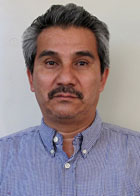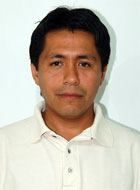Journal of Natural Sciences, 1(1), pp. 29-39.
Abstract
We studied the Chromium (VI) removal capacity in aqueous solution by the mandarin shell, using the diphenylcarbazide method to evaluate the metal concentration. So, the highest biosorption of the metal (50 mg/L) occurs within 6.5 hours, at pH of 1.0 and 28 °C. According to temperature, the highest removal was observed at 60 °C, in 40 minutes, when the metal (50mg/L) is completely adsorbed. At the analyzed concentrations of Cr (VI), mandarin shell, showed excellent removal capacity, besides it removes efficiently the metal in situ (94.65% removal, 6 days of incubation, 5 g of biomass). After 1 hour of incubation, the studied biomass reduces 1.0 g of Cr (VI) with the simultaneous production of Cr (III); so, it can be used to eliminate it from industrial wastewater.
Full Text: PDF
Rodríguez et al. (2013). Hexavalent Chromium Removal Citrus reticulata SHELL. Journal of Natural Sciences, 1(1), pp. 29-39.
Acosta, I., López, V., Coronado, E., Cárdenas, J.F. y Martínez, V.M. (2010). Remoción de Cromo (VI) por la biomasa de la cáscara de Tamarindo, (Tamarindus indica). Revista de Biotecnología y Bioingeniería. 14 (3), 11-23.
Acosta, I., Sandoval, P., Bautista, D., Hernández, N., Cárdenas, J.F. y Martínez; V.M.(2012). Bioadsorción de Cromo (VI) por la cáscara de Mamey (Mammea americana L.). Avances en Ciencias e Ingeniería, Vol. 3, No. 2, (Abril.-Junio 2012). IN PRESS.
Agarwal, G.S., Kumar, H., andS. Chaudari.(2006).Biosorption of aqueous chromium (VI) byTamarindusindicaseeds.Bioresource Technology. 97, 949-956.
Aldrich, M.V., GardeaTorresdey, J.L., PeraltaVidea, J.R., and Parsons, J.G. (2003).Uptake and Reduction of Cr(VI) to Cr(III) by Mesquite (Prosopis ssp.): Chromate-Plant Interaction in Hydroponics and Solid Media Studied Using XAS.Environmental Science Technology. 37, 1859-1864.
Arthanareeswaran, G., Thanikaivelan, P., Jaya, N., Mohan, D., and Raajenthiren, M. (2002).Removal of chromium from aqueous solution using cellulose acetate and sulfonatedpoly(ether ketone) blend ultrafiltration membranes.Biochemical Engineering Journal. 12, 43-153.
Bai, R.S. and Abraham, T.E. (2001).Biosorption of chromium (VI) from aqueous solution byRhizopusnigricans.Bioresource Technology, 79, 73-81.
Beszedits, S. (1988). Chromium removal from industrial wastewaters.In J.O. Nriagu and E. Nieboer (Eds.) Chromium in the natural and human environments(pp. 232-263).New York: John Wiley.
Cárdenas-González, J.F. and Acosta-Rodríguez, I. (2011). Hexavalent chromium removal by a Paecilomycesspfungal.In: Syed ShahidShaukat (ed), Progress in Biomass and Bioenergy Production. Croatia. Chapter 7. (pp 133-150). .INTECH. Croatia.
Cervantes, C., Campos-García, J., Devars, S., Gutiérrez-Corona, F., Loza-Tavera, H., Torres-Gúzman, J.C., and Moreno- Sánchez, R. (2001). Interactions of chromium with microorganisms and plants.FEMS Microbiology Review.25, 335-347.
Chen, S., Yue, Q., Gao, B., Li, Q., and Xu, X. (2011). Removal of Cr(VI) from aqueous solution using modified corn stalks: Characteristic, equilibrium, kinetic and thermodynamic study. Chemical Engineering Journal. 168, 909-917.
Cimino, G., Passerini, A., and Toscano, G. (2000).Removal of toxic cations and Cr(VI) from aqueous solution by Halzelnut shell.Water Research. 34 (11), 2955-2962.
Dakiki, M., Khamis, M., Manassra, A., and Mer’eb, M. (2002).Selective adsorption of chromium (VI) in industrial wastewater using low cost abundantly adsorbents.Advances Environmental Research, 6, 533-540.
Fiol, N., Escudero, C., and Villaescusa, I. (2008). Chromium sorption and Cr(VI) reduction to Cr(III) by grape stalks and yohimbe bark.Bioresource Technology. 99, 5030-5036.
Fukuda, T., Ishino, Y., Ogawa, A., Tsutsumi, K., and Morita, H. (2008).Cr(VI) reduction from contaminated soils by Aspergillussp. N2 and Penicillium sp. N3 isolated from chromium deposits.Journal of General andApplied Microbiology. 54, 295-303.
Greenberg, A.E., Clesceri, L.S., and Eaton, A.D. (1992).Standard methods for the examination of water and wastewater.18a ed. American Public Health Association. (pp. 58-3.60, 187-190).Washington, D.C.
Gupta, S., and Babu, B.V. (2009).Removal of toxic metal Cr(VI) from aqueous solutions using sawdust as adsorbent: Equilibrium, kinetics and regeneration studies. Chemical EngineeringJournal.150, 352-365.
Gupta, V.K., Shrivastava, A.K., and Jain, N. (2001).Biosorption of chromium(VI) from aqueous solution bygreen algae Spirogyra species.Water Research.35, 4079–4085.
Jnr, M.H. andSpiff,A.I.(2005). Effects of temperature on thesorption of Pb2+ and Cd2+ from aqueous solution byCaladium bicolor (wild cocoyam) biomass.Electronic Journal of Biotechnology.8, (2), 162–169.
Leyva-Ramos, R., L.A. Bernal-Jacome, L.A., and Acosta-Rodriguez, I. (2005). Adsorption of cadmium(II) from aqueous solution on natural and oxidized corncob.Separation and Purification Technology.45, 41–49.
Lofroth, G. and Ames, B.N. (1978).Mutagenicity of inorganic compounds in Salmonella typhimurium: Arsenic, chromium and selenium. Mutation Research, 53, 65-66.
Marsh, T.L. and McInerney, M.J. (2001).Relationship of hydrogen bioavailability to chromate reduction in aquifer sediments.Applied and Environmental Microbiology, 6, 1517- 1521.
Ozer, A.andOzer, D. (2003). Comparitive study of thebiosorption of Pb (II), Ni (II) and Cr(VI) ions onto S. cerevisiae: Determination of biosorption heats.Journal of Hazardous Materials.100, 219–229.
Park, D., Yung, Y.S., Cho, H.Y., and Park, J.M. (2004).Chromium biosorption by thermally treated biomass of the brown seaweed, Eckloniasp. Industrial and Engineering Chemistry Research. 43, 8226-8232.
Park, D., Yung, Y.S., and Park, J.M. (2004).Reduction of Hexavalent chromium with the brown seaweed EckloniaBiomass.Environmental Science Technology.38, 4860-4864,
Pérez-Marín, A.B., Meseguer, V., Zapata, J.F., Ortuño, M., Aguilar, J., Sáez S., and Lloréns, M. (2007). Removal of cadmium from aqueous solutions by adsorption onto orange waste.J. Hazardous Materials. 139, 122-131.
Popuri, R.S., Jammala, A., Naga Suresh, K., and Abuburi, K. (2007).Biosorption of hexavalent chromium using tamarind (Tamarindusindica) fruit shell-a comparative study.Journal of Biotechnology, 10 (3), 358-367.
Ramírez-Ramírez, R., Calvo-Méndez, C., Avila- Rodríguez, M., Lappe, P., Ulloa, M., Vázquez-Juárez, R., and Gutiérrez-
Corona, J.F. (2004). Cr(VI) reduction in a Chromate-resistant strain of Candida maltose isolated from the leather industry.Antonie van Leeuwenhoek. 85, 63-68.
Razmovski, N.R.N. and Sciban, M.B. (2007). Effect of different conditions on Cu(II) and Cr(VI) biosorption by dried waste tea fungal biomass. APTEFF, 38, 1-19.
Sag, Y. and Aktay, Y. (2002).Kinetic studies on sorption of Cr (VI) and CU (II) ions by chitin, chitosan andRhizopusarrhizus.Biochemical Engineering Journal. 12, 143-153
Sahin, Y. and Öztürk, A. (2005).Biosorption of chromium (VI) ions from aqueous solution by the bacterium Bacillus thuriengensis.Process Biochemistry. 40, 1895-1901.
Sarin, V. and Pant, K.K. (2006).Removal of chromium from industrial waste by using eucalyptus bark.Bioresource Technology, 97, 15-20.
Seng, H. and Wang, Y.T. (1994).Biological reduction of chromium by E. coli, Journal of Environmental Engineering. 120, 560-572.
Shafqat, F., Bhatti, H.N., Hanif, M.A., and Zubair, A. (2008).Kinetic and equilibrium studies of Cr(III) and Cr(VI) sorption from aqueous solution using rosagrussanteplitz (Red rose) waste biomass. Journal Chile Chemistry Society, 53 (4), 1667-1672.
Sharanavard, M., Ahmadpourand, A., and Reza Doosti, M. (2011).Biosorption of Hexavalent Chromium Ions from Aqueous Solutions using Almond Green Hull as a Low-Cost Biosorbent. European Journal of Scientific Research. 58 (3), 392-400.
Singh, K.K., Hasan, S.H., Talat, M., Singh, V.K., and Gangwar, S.K. (2009).Removal of Cr (VI) from aqueous solutions using wheat bran.Chemical Engineering Journal. 151, 113-121. 2009.
Smith, W.A., Apel, W.A., Petersen, J.N., and Peyton, B.M. (2002).Effect of carbon and energy source on bacterial chromate reduction.Bioremediation Journal. 6, 205-215.
Tewari, N., Vasudevan, P., and Guha, B. (2005).Study on biosorption of Cr(VI) byMucorhiemalis.Biochemical Engineering Journal. 23, 185-192.
Volesky, V. and Holan, Z.R. (1995).Biosorption of heavy metals.Biotechnology Progress. 11 (3), 235-250.
Wang, X.S., Tang, Y.P., and Tao, S.R. (2009).Kinetics, equilibrium and thermodynamic study on removal of Cr (VI) from aqueous solutions using lowcost adsorbent Alligator weed.Chemical Engineering Journal. 148, 217-225.
Xu, X. R., Li, H.B., Gu, J.D., and Li, X. Y. (2005). Kinetics of the reduction of Chromium (VI) by Vitamin C.Environmental Toxicology and Chemistry.24, (6), 1310-1314.
Yong, L., Xin-Hua; X., and Ping, H. (2005).Remediation of Cr (VI) in solution using vitamin C.Journal of Zhejiang University Science. 6B, (6), 540-542.
Zubair, A., Bhatti, H.N., Hanif. M.A., and Shafqat, F. (2008).Kinetic and equilibrium modeling for Cr(III) and Cr(VI) removal from aqueous solutions by Citrus reticulate waste biomass.Water Air Soil Pollution. 191, 305-318.

Jose Ismael Acosta Rodríguez is a full time research professor from Investigation Center and Graduate Studies in Chemical Science Faculty which belong to Autonomous University of San Luis Potosi. He obtained his degree in 1976-1982 period in the Chemical Science Faculty of the Autonomous University of San Luis Potosi, after, he carry out master studies in Chemical Faculty of the Guanajuato University from 1982-1984 period and obtain his Ph D (Microbiology Science Doctoral) in the Investigation Institute of Experimental Biology, in Guanajuato University around 1996-2001. He is professor of genetics and biotechnology topics of the Chemical Pharmaceutical Biologist career from Autonomous University of San Luis Potosi.
He has many national and international publications, in additions to presentations at national and international congress. His investigation area implicate: use of different natural biomasses and fungus cellular biomasses to eliminate heavy metals, pesticides, and dyes from contaminated sites. Also extracellular lytic enzymes of phytopathogens fungal studies, fungal and bacterial oil resistant studies, and studies of fungi macromycetes of different places.
Contact number: 001444 8262440 ext. 6554

Juan Cárdenas is a doctoral student of the Autonomous University of San Luis Potosi. His studies and research involving microbiology and biotechnology in different areas, for example, soil and wastewaters. He earned his degree in the Faculty of Chemical Science in 2004, where began his introduction to environmental remediation in the laboratory of experimental micology in the Faculty of Chemical Science in Autonomous University of San Luis Potosi. He held a Master degree in Bioprocess in the same faculty, in 2007-2009.
He is currently pursuing the doctoral studies in Engineering and Materials Science, which belong at Faculty of Science in Autonomous University of San Luis Potosi with the topic “Physical-chemical study of the Chromate reductase enzyme present in the environmental fungus Paecilomyces sp.”
His research is based on the elimination of heavy metals, herbicides, pesticides, oil and some other pollutants, using different natural biomasses, like Citrus ReticulataShell, Citrus Limonium Shell, Litchi ChinensisSonn Peel, TamarindusIndica Shell, and some others natural biomasses. He also works with different fungal biomass likePaecilomycessp, Fusariumsolani, Aspergillusniger, Penicilliumsp, Candida albicans, Aureobasidiumpullulans.
He and his working group has published many articles and book chapters in different research journals nationally and internationally, in addition to presenting their work at various conferences.
Contact Number: 0014448262440 ext. 6554. Cellular: 4441226560
Elida Coronado-Quintero
Universidad Autónoma de San Luis Potosí,
Facultad de Ciencias Químicas
Centro de Investigación y de Estudios de Posgrado,
Laboratorio de Micología Experimental
Juana Tovar-Oviedo
Laboratorio de Microbiología. Av. Dr. Manuel Nava No. 6
Zona Universitaria, bLaboratorio de Microbiología. Av. Dr. Manuel Nava No. 6
Zona Universitaria, 78210 San Luis Potosí, S.L.P. México
78210 San Luis Potosí, S.L.P. México
Víctor Manuel Martínez-Juárez
Universidad Autónoma del Estado de Hidalgo,
Instituto de Ciencias Agropecuarias,
Área Académica de Medicina Veterinaria y Zootecnia. A. Universidad Km.
1. Rancho Universitario. C.P. 43 600.Tulancingo de Bravo Hidalgo, México.
Browse Journals
Journal Policies
Information
Useful Links
- Call for Papers
- Submit Your Paper
- Publish in Your Native Language
- Subscribe the Journal
- Frequently Asked Questions
- Contact the Executive Editor
- Recommend this Journal to Librarian
- View the Current Issue
- View the Previous Issues
- Recommend this Journal to Friends
- Recommend a Special Issue
- Comment on the Journal
- Publish the Conference Proceedings
Latest Activities
Resources
Visiting Status
| 41 | |
| |
277 |
| |
2083 |
| |
6429 |
| 1011843 | |
| 7 |
 The Brooklyn Research and Publishing Institute
The Brooklyn Research and Publishing Institute